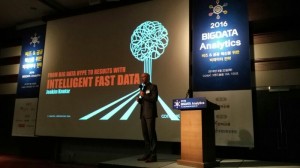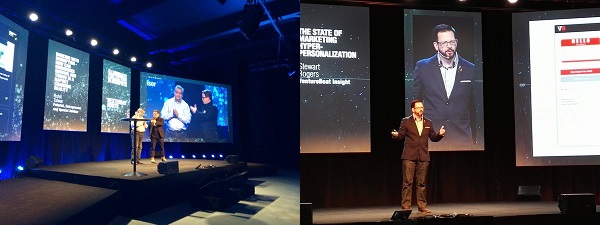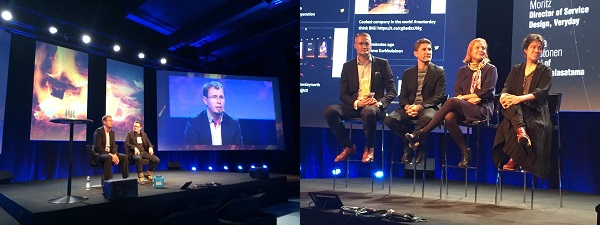Posted: August 2nd, 2016 | Author: Steve Hateley | Filed under: Industry Insights | Tags: data monetisation, revenue monetisation, sponsored data | No Comments »
Pop quiz: which app holds the record for the most launch-week U.S. downloads in the history of Apple’s App Store? Unless you’ve been living under a rock, the answer should be fairly easy: it’s Pokémon GO. 
The app has been a pop culture sensation since launching in the U.S., Australia, the U.K. and New Zealand. It’s the biggest mobile game in U.S. history, and enjoys 21 million daily users on average. The average mobile iOS user spends more time on the Pokémon GO than they do Facebook, Snapchat, Twitter and Instagram.
That level of engagement for a brand-new app is extraordinary. Recognising that fact, T-Mobile U.S. rolled out a compelling offer for its mobile subscribers as part of its “T-Mobile Tuesdays” campaign: free, unlimited data to play Pokémon GO for up to one year.
T-Mobile has been at the forefront of programs that make data available to subscribers for free. Its “Binge On” program allows customers to access more than 75 streaming video services without using their monthly 4G LTE data allotment.
Customers love streaming content and games, but they are reluctant to engage with certain activities because it’s perceived they might consume too much of their data allowance. Sponsored data programs let them engage with those services because the cost of data consumption is covered by an enterprise, such as the content provider.
Through agreements with streaming content providers or mobile app developers, operators remove the financial barriers that might have discouraged customers from accessing these data-hungry services. As an effective monetisation strategy, sponsored data endears you to your customers, establishes greater levels of satisfaction and loyalty, increases data consumption and creates long-term revenue-generation opportunities.
At this past TM Forum Live! in Nice, we demonstrated a business model for enterprise sponsored data through a Catalyst championed by Orange. Our initiative – which was awarded “Most Innovative Catalyst – Commercial in the Communications Industry” – used Comptel’s Intelligent Fast Data capabilities to create personalised data offerings for enterprise customers, allowing those enterprises to collect usage data and apply policy control.
It’s not just streaming content providers who can get involved. Operators could identify new avenues to revenue in the B2B market. A business could purchase a corporate data allowance, for example, that sponsors all data its employees use to access corporate services, like Office 365, via their personal mobile devices. That eliminates any potential hesitancy on the part of employees, who otherwise may not want to use up their personal data allowance for work purposes.
Whether for work or play, sponsored data programs could be a major opportunity for operators to drive more revenue opportunities from data services. As digital services take up a bigger share of smartphone usage compared to voice and mobile, these new avenues to revenue will be crucial for operator business growth.
Read more about Comptel’s Catalysts at TM Forum Live! 2016, which included partnerships with Orange, Telefonica, Salesforce and IBM. Keep up with the conversation around mobile monetisation at Nexterday.org, our reader community and online magazine.
Posted: April 12th, 2016 | Author: Joakim Knutar | Filed under: Industry Insights | Tags: big data, ETNews | No Comments »
ETNews organised a Big Data Seminar in Seoul on 22-23rd of March. Several hundreds of experts from the Big Data field came together to hear about great ex

amples and technologies, and to share experiences. Comptel had the pleasure of joining Team Finland with a speaker slot together with IOT specialists BaseN and Wirepas.
So what created most buzz?
Nokia had the opening keynote talking about internal and external data, and how all data should be used to improve predictions. Interesting IOT areas were energy, digital health, and connected cars. Also emphasised was privacy and how all connected devices will bring further challenges when it comes to privacy matter.
A very interesting keynote was given by famous designer Youngse Kim. He explained how it will be difficult to drive consumer value out of data unless you have Big Design. He explained how consumer design is all about predicting and how this focus on big data will drive momentum into the design-space as well. Mr. Kim further noted that big data and IOT will only be commercialised because of Big Design. New industries will emerge. The design will be at the center of new business for companies who succeed. A good example were two designers who wanted to design hotels, but went on a sidetrack and created Airbnb.
The retail side was represented by Tom Spencer from dunnhumby. Key takeaways were how they use big data to create loyalty, and the need for a Chief Data Officer in every organisation. He also showed how everyone need to climb the analytics capability ladder before they will truly be able to turn data into value.
With the growing complexity of data gathering, analysis, and exchange we cannot but agree with Mr. Spencer on the fact that most organisations today lack a person in charge of a good vision for big data and strategy.
ShinhanCard showed very interesting figures and examples on how they have been able to grow their business with big data. With 22 million members they discovered that they needed to segment their customers and create segment specific credit cards. Today they have 11 different cards. They also talked about how they used real-time data to help the government at the time of the MERS outbreak last year. Or what do you think about analysing how far people are willing to travel for cheaper products? Or using mobile phone credit rating data to give loans?
Another hot topic to be noted was real-time analytics. Most of the presentations had some degree of real-timeless in them, and it was great to see that Comptel is not the only one who have realised that the best way to value from data comes from Intelligent Fast Data.
I had the honor of presenting Comptel’s Intelligent Fast Data and how to get value out of data using real-time analytics and actions. Our Nexterday was, of course, part of the story, and it is interesting to see that Nexterday is really cross-industry. Not only for Telco, but for IT in general and any industry who need to serve their customers better. Remember, focus your customer, not customers.
It seems that contextuality is really picking up. Meaning that it is understood that data is most valuable when it is fresh and used at the moment. This becomes even more critical when moving into IOT. So the question is: Is your infrastructure equipped for Nexterday?
As part of the Team Finland delegation, we also had a chance to have separate meetings with many interesting companies. Truly inspiring to see what is going on in Korea and the potential that is there. To be continued…
Posted: February 19th, 2016 | Author: Ari Vänttinen | Filed under: Industry Insights | Tags: customer experience, digitalisation, Mobile World Congress, Nexterday | No Comments »
For Comptel, the past year has been all about sharing our ideas around the digital business transformation operators must undergo to deliver perfect digital moments to customers. Now, we’re challenging operators to take the next step and put those ideas into action.
We’ve published Nexterday: Volume II, a follow-up to our previous book, Operation Nexterday. You can pick up a hard copy of the book at this year’s Mobile World Congress or download a digital version by visiting our new online magazine and community, Nexterday.org. With this edition, our goal is to help each operator become a “Perfect Digital Company,” one that works for and with its customers to enhance the digital moments that make up life.
To achieve that, operators need to open their minds to fresh ways of thinking about serving customers, taking inspiration from their counterparts across the globe and visionary, non-telco businesses that are changing the face of digitalisation.
The Customer is in Charge
Generation Cloud is, as always, at the centre of the digital struggle. B2B and B2C customers crave the autonomy to customise, configure and purchase digital services at a faster pace and on their own terms. On top of that, operators are increasingly starting to play in non-traditional markets, including connected devices, smart cities and healthcare, in both established and emerging markets.
Technology advancements – from the introduction of and ongoing management needs for virtualised network functions to the rising importance of real-time data in sales, marketing and service management – mean operators have more tools at their disposal to serve buyers’ unique interests and succeed in new verticals.
The challenge is determining how to effectively leverage these tools, while also applying the creativity and radical ideas operators need to distinguish their service at a time when customers are willing to switch digital and communications service providers at a moment’s notice. It’s not just about offering dynamic new services, but also delivering those services as part of a more pleasant and fulfilling customer experience.
Creating Perfect Digital Moments
Nexterday: Volume II describes how your business can evolve to meet the needs of a changing digital economy. The book includes:
- Inspiring real-world examples of telco and non-telco businesses that strive to offer customers extraordinary digital experiences
- Perspectives on the qualities of leading digital businesses from economist Dr. Kjell Nordström and business experts Stefan Moritz, Mark Curtis and Jeetu Mahtani
- In-depth research from analysts Stewart Rogers, Fredrik Jungermann, Caroline Chappell and Steve Bell
- Blueprints on how operators can automate their enterprise sales approach, pursue Internet of Things (IoT) service opportunities, create a richer B2C customer experience and re-engineer their back end for accelerated service delivery and enhanced digital service lifecycle management
Though we believe strongly in the themes we cover in the book, we want it to inspire a rich dialogue about the state of our digitalisation. We invite book readers to visit Nexterday.org to share their opinions and challenge our thinking. Whether you agree or disagree, we want to hear from you at Nexterday.org. Registration is simple: just sign up with your LinkedIn account.
Nexterday: Volume II, which will be available in hard and digital copies, will be officially released at our #Nexterday party on Wednesday, 24 February at 7 p.m. CET during Mobile World Congress. We’ll have live performances, an open bar and plenty of opportunities to unwind and mingle. You can pick up an exclusive ticket at the Comptel booth (stand 5G40 in hall 5). If you are not attending Mobile World Congress, you can download a digital copy of the book at Nexterday.org.
We invite you to join the movement and become a ‘Perfect Digital Company’ that serves the best interests of its customers. Nexterday: Volume II will show you how.
Posted: February 12th, 2016 | Author: Juhani Hintikka | Filed under: Industry Insights | Tags: FWD, Nexterday North, Operation Nexterday | No Comments »
We’re only one month in to 2016, and already the team here at Comptel has been busy on multiple fronts. We’re putting the final touches on our follow-up to our successful book Operation Nexterday. You’ll be able to get a full hard copy of Nexterday Volume II at this year’s Mobile World Congress, and we’ll also have a download link on our soon-to-be-launched website, Nexterday.org.
We have much more in store for this year, but before we get too far ahead of ourselves, it’s worth taking a quick look back and the progress Comptel made in the past 13 months. As it turned out, 2015 was a hallmark year for Comptel. We’ve been an important player in this industry for 30 years, working hard to deliver solutions that keep our telco customers competitive.
However, we recognised the playbooks that we – and the industry as a whole – have relied on for so long are broken. We used last year to pioneer change in the way that this market serves its customers, embracing digitalisation and helping operators learn how they can become the perfect digital company.
Along the way, we developed product innovations that support our vision of Nexterday, partnered strategically and are proud to have been recognised for all we accomplished. With that in mind, here are a few highlights from Comptel’s transformative 2015:
Operation Nexterday
Last year we launched Operation Nexterday – a mission and framework encouraging operators to redefine their sales, marketing, technology and service approach to better suit the demands of the tech-savvy digital natives that make up Generation Cloud.
We wrote a 150-page book explaining how the evolution in B2B and B2C buyer demands is challenging the telco industry, and outlining steps to achieve Nexterday – from perfecting the digital buying experience and monetising new services faster, to orchestrating network functions from ground to cloud and utilising intelligent, fast data.
The book compiled insights from industry experts within Comptel and across the digital and communications landscape, including analysts and academics. It was published at Mobile World Congress 2015, with more than 5,000 copies distributed since.
Nexterday North
The success of the book led us to launch our first “anti-seminar.” In November, we held the inaugural Nexterday North event in Helsinki, Finland, as a side event to the global startup conference Slush. The event focused on digitalisation and motivating operators to think about the telco world with a non-traditional mindset. Nexterday North brought together more than 500 Comptel customers, partners, key industry players and futuristic business thinkers from around the world to examine digital services as the next major revenue stream for telcos.
Product Innovations
Our product teams kept their foot on the gas and worked tirelessly to develop solutions that would help our customers succeed in Nexterday.
 MONETIZER™, brought to market in July 2015, is an industry-first business policy and charging toolset enabling digital and communications service providers to innovate and design rich service offers instantly. With MONETIZER™, you can create, configure, launch and modify dynamic, contextual packages – and profit from consumers’ data usage – in minutes instead of months.
MONETIZER™, brought to market in July 2015, is an industry-first business policy and charging toolset enabling digital and communications service providers to innovate and design rich service offers instantly. With MONETIZER™, you can create, configure, launch and modify dynamic, contextual packages – and profit from consumers’ data usage – in minutes instead of months.
At Nexterday North, we launched FWD, an easy and contextual solution for operators to sell and market time-based mobile data directly from a smartphone. The FWD app makes buying mobile data fast, convenient and personal for consumers, while giving operators an easy-to-manage digital sales and marketing channel to maximise data revenues.
Industry Collaboration
We also extended our work with partners in our industry in an effort to help shape the future of telco.
We launched a four-month-long program with long-standing customer Saudi Telecom Company (STC) to develop the next generation of IT talent in Saudi Arabia. The program educates young Saudi professionals on communications networks, strengthens their knowledge of Comptel’s technologies and enables them for future leadership positions within STC.
Comptel also joined a partnership with Pivotal to market their solutions together in the Asia-Pacific region. The partnership enables operators to immediately act on data with easy, quick access to Comptel’s packaged data analytics applications via the Pivotal Big Data Suite.
Industry Recognition and Accolades
We achieved several proof points of excellence in 2015, including recognition by CIO Review as one of the 20 most promising M2M Solution Providers in 2015, and the Best Performing IT Team by TDC. The Comptel Operational Intelligence Model won OSS Innovation of the Year in the TelecomAsia Readers’ Choice and Innovation Awards, and the company’s work to evolve Chorus New Zealand’s fulfilment system was honoured with a Global Telecoms Business Award. Congratulations to my colleagues here at Comptel for earning this prestigious recognition!
We’re Only Getting Started
It’s fine to pat yourself on the back once in a while, and I’m certainly proud of what our team was able to achieve last year. However, in an industry that’s always evolving, we always want to be moving forward. Last year showed what Comptel is capable of, but we’ve only scratched the surface. In 2016, our mission is to execute on the ideas we introduced last year and turn those concepts into action. We’re challenging operators to create perfect digital companies for and with their customers. We invite you to join us on our journey toward Nexterday and to start transforming your business as well.
Comptel will be in Barcelona for Mobile World Congress 2016 (Hall 5, Stand 5G40). We’ll launch our latest book, Nexterday Volume II, and host a #Nexterday party on Wednesday, 24 February at 7 p.m. CET. To book a meeting, contact your Comptel account manager or send us an email at [email protected].
Posted: January 7th, 2016 | Author: Ari Vänttinen | Filed under: Industry Insights | Tags: Operation Nexterday | No Comments »
In 2015, Comptel challenged operators to embark on their own “Operation Nexterday” – a mission to redefine their sales, marketing, technology and service approach to better suit the demands of the tech-savvy digital natives that make up Generation Cloud. Our challenge manifested in several ways – we published a book explaining the challenge and outlining steps to achieve it, launched an event to introduce new ideas and insights, and encouraged new conversations with operators who were ready to take the jump into Nexterday.
The Comptel blog was also busy covering various aspects of the Nexterday mission. Here, we look back on the five most popular blogs we published in 2015.
Slush 2015 and Nexterday North: A One-Two Punch for Innovation
Our vision for Nexterday culminated in our first ever major anti-seminar. Nexterday North took place in the two days immediately preceding Slush – the largest startup conference in Europe – giving visitors to Helsinki a full week’s worth of fresh ideas, big announcements and new visions for the future of telco, digitalisation and business. Our most popular blog of the year got attendees excited for both events.
How a Push for NFV Standardisation Brought Comptel to ETSI
Network functions virtualisation (NFV) continued to be a hot topic in 2015, and many operators have discussed their desire to see better standardisation around the implementation of this emerging technology. In this blog, Comptel Director of Business Architecture Stephen Lacey explained how we lend our voice to the NFV standards discussion as a member of the European Telecommunications Standards Institute (ETSI).
Mobile World Congress Recap: 3 Key Takeaways on the Future of Mobile Communications
Last year’s Mobile World Congress was an exciting one for Comptel – that’s where we launched Operation Nexterday, our guide to how operators can rewrite their sales, marketing and service playbooks for Nexterday. The event also offered a great look into the trends that are affecting the telco industry, and in this blog post I recapped the top three takeaways I drew from the show.
Comptel, STC Partner to Train Saudi Arabia’s Future IT Leaders
One of Comptel’s most exciting stories of the year involved our work with Saudi Arabian operator STC. As a long-time customer, STC reached out to Comptel for support launching a brand-new employee training initiative. Through the four-month program, we helped train the next generation of Saudi telecommunications professionals with courses in Riyadh, Helsinki and Kuala Lumpur. We’re proud to play a role in youth IT education – read more in this blog from Comptel Senior Vice President, MEA, Mika Korpinen.
Bye Bye, Big Data – Hello Intelligent Fast Data
Big Data is a big disappointment – at least, that’s how some IT executives view it after prior data investments and initiatives felt short of lofty promises. In this blog, Comptel CTO Mikko Jarva argued that the failures of Big Data are a reflection of poor execution, and that to truly make the most of their customer data for greater business opportunities and revenue, operators need to account for every new raw data source and turn that data into real-time contextual decisions and actions. In short, it’s a push toward Intelligent Fast Data.
Learn more about our challenge to operators to evolve their sales, marketing and service playbooks for a new generation of buyer. Download and read “Operation Nexterday.”
Posted: December 15th, 2015 | Author: Simo Isomaki | Filed under: Industry Insights | Tags: Monetisation, VoLTE | No Comments »
When we wrote about the state of the Voice over LTE (VoLTE) market little while ago, we discussed the obstacles that operators could face when deploying the emerging technology. Although the number of VoLTE projects is growing, it’s worth asking the question: just how disruptive will high-definition voice be as a revenue generator?
The answer? It’s hard to believe that VoLTE will be the killer app that significantly increases operator revenue.
That’s because, from the consumer perspective, it won’t seem like much has changed at all. They will still open the voice “app” on their phone to make a call. Yes, there will be a handful of new features, including the ability to switch from an audio call to a video call, and, of course, superior voice quality. But, these aren’t features consumers would necessarily want to pay extra for, and if operators charge the same for VoLTE as they do traditional calls, the revenue point is moot.
However, that doesn’t invalidate VoLTE’s value as a service differentiator. The key to unlocking new sources of revenue from VoLTE will be in adopting a flexible monetisation approach.
That will require operators to think beyond pre-configured VoLTE service packages. Operators might opt for these because it seems to be an easier way to try an emerging technology, but they put themselves at a disadvantage.
When the vendor controls everything about how VoLTE is configured, you can only sell the service the way the vendor has dictated. You aren’t able to customise the way you implement and monetise VoLTE based on local market factors. It can often take you longer to implement the technology in the first place or change your implementation based on new developments. Overall, this means operators are slower, less proactive and have a harder time meeting customers’ unique needs.
It also limits other benefits of a VoLTE deployment including efficiency in the network, the ability to reform the cellular spectrum and improved cost competitiveness. Those will all save operators money, but they don’t add up to dramatically improved revenue. It’s better if operators have the power to customise VoLTE implementation and monetisation.
Perhaps you want to bundle VoLTE and Voice over Wi-Fi (VoWiFi) services together. Maybe you don’t. Maybe you want to give VoLTE away to enterprise customers free of charge, bundling it as part of a larger corporate offering. Or maybe you’ve thought of an entirely new way to monetise the new technology that no one else has considered.
Ultimately, it should be up to you, not your vendor, to find the right way forward. Configurability in service monetisation is a key factor in achieving business elasticity, a concept we’ve discussed recently. For operators to be elastic – which defines their ability to change, upgrade, improve and react quickly to dynamic market changes – they will need to ensure their VoLTE capabilities are free from the fixed limitations of traditional vendor engagements. Elasticity is a key capability that requires fast, tailored, highly responsive customer service.
VoLTE is not a silver bullet, but that doesn’t mean operators should leave money on the table. Opt for a vendor that will let you configure VoLTE the way you want, and then start thinking of creative new ways to monetise it.
If you missed it, read the first blog post in this series, where we evaluated VoLTE pros and cons. And keep an eye out for our next piece, where we’ll cover the future of VoLTE and where we think this emerging technology will fit in the broader world of digital and communications services. If you want to control your own destiny and deploy VoLTE features the way you want it, the MONETIZER™ is there for you.
Posted: November 11th, 2015 | Author: Ari Vänttinen | Filed under: Events, Industry Insights | Tags: Nexterday North, Operation Nexterday | No Comments »
 Although Comptel’s inaugural Nexterday North has wrapped up, post-event enthusiasm hasn’t faded at all. Take a few seconds to scroll through comments on our official Twitter hashtags – #Nexterday and #NexterdayNorth – and you’ll get a sense of the massive number of ideas and insights attendees were able to gain over two inspiring days in Helsinki.
Although Comptel’s inaugural Nexterday North has wrapped up, post-event enthusiasm hasn’t faded at all. Take a few seconds to scroll through comments on our official Twitter hashtags – #Nexterday and #NexterdayNorth – and you’ll get a sense of the massive number of ideas and insights attendees were able to gain over two inspiring days in Helsinki.
As our CEO Juhani Hintikka said in his closing remarks, we are grateful to all of the partners, colleagues, speakers and guests who helped make our first antiseminar such a success. Plenty of blogs and articles have already been written recapping Nexterday North – check out the links at the bottom of this post for some of those – but here’s three of our own parting thoughts from the first Comptel anti-seminar.

Futurist Rohit Talwar (left), Stewart Rogers of VentureBeat Insights
There is Hope for Humanity
Those were the words Juhani used to describe Day 1 of Nexterday North, and it’s easy to see why. Our first day’s presenters offered a hopeful message of perseverance, potential and positive transformation.
Futurist Patrick Dixon’s energetic presentation taught us that emotion is the single most important driver of the future of technology, business and culture. Successful businesses remember that and seek to satisfy their customers on an emotional level. WIRED’s Gregg Williams shared a similar take, saying “It’s just as important to take bad things out of people’s lives as it is to add good things.”
Riisto Siilasmaa’s candid talk on Nokia’s business transformation had the crowd buzzing, and he offered a compelling walk-through of how he helped lead the company through one of its most challenging time periods. It was an inspiring lesson for the crowd that even in difficult times, there is always hope if you can commit to change.

Ted Matsumoto of Softbank (left), Horacio Goldenberg of Telefonica
Customers Drive the Future
A consistent theme through every session – and especially on Day 2 – was the importance of putting customers at the centre of business strategy.
Our moderator, Ville Tolvanen, hosted a fascinating fireside chat with T-Mobile’s Milan Ruzicka that explored the company’s popular customer-centric Uncarrier movement. In a panel discussion Smart Kalasatama’s Veera Mustonen suggested that business transparency earns customer trust, while Tele2’s Lars Torstensson explained consumers’ desire to set their own service terms.
Of course, you need strategy and structure to put customers at the centre. SoftBank’s Ted Matsumoto offered a compelling business model to help operators fine-tune to customer needs. We also heard from experts on the data, service architecture and monetisation strategies that will play a vital role in operators’ business transformation.

Mehackit's Cycle for Technology (left) and the launch of FWD
It’s Time for New Ways of Thinking
Many of the presentations also focused on the new service opportunities available to operators, from app development to smart cities to digital servies.
VentureBeat’s Stewart Rogers described new insights into hyper-personalized marketing that could deliver richer customer engagement. Futurist Rohit Talwar suggested a business pairing – experienced workers with younger ones – to balance the need for structure and discipline with the desire to innovate. And storyteller Linda Liukas advocated that children today could be the next generation of innovators if we make learning about technology fun and exciting.
Nexterday North was an exciting and inspiring event with more than a few surprises, including the launch of Comptel’s FWD app, which we believe will change how operators sell and market mobile data forever. Ultimately, Nexterday North proved that when you think differently, you uncover ways to make the world a better place for everyone.

Read more about Nexterday North below:
How Nokia’s chairman demanded €2bn from Steve Ballmer
Telcos need to emulate SoftBank & decouple network / services businesses
Look to the future to survive disruption
Comptel’s Nexterday
Hackers’ Advantage Over Security Professionals: A Willingness To Share
Time Based Mobile Internet Data Purchase Finally Arrives
Forget Big Data, use “Little Data” instead
Posted: November 9th, 2015 | Author: Special Contributor | Filed under: Industry Insights | Tags: Nexterday North, social media, TweetAtlas | No Comments »
By Sofia Nylund, Marketing and Communications Coordinator, TweetAtlas
The post-digital era is here and the Nexterday of business looks unruly, but at the same time extremely inspiring, challenging and prosperous. When new playbooks are rewritten you don’t want to be on the sidelines. It is time to think ahead, again and beyond.
These are the words Comptel uses to describe its event Nexterday North, taking place in Helsinki on November 9th-10th. Together with a broad range of ecosystem partners such as Tech Mahindra, IBM, CloudSense, Hitachi and TATA Consultancy Services, Comptel is presenting six conceptually innovative industry blueprints in order to guide operators’ digital business and IT transformations.
The Nexterday blueprint “Hyper-Personalised Customer Engagement” focuses on how to drive new revenues through automated intelligent actions. It explores how companies can achieve smart real-time decisions for upselling services by targeting the right customers through the right channels with the right content, including analytics and sharp decision-making technologies.
So, in what sense will business playbooks be rewritten? When speaking of the fields of marketing and communications, technology and digital advancements have really changed the whole landscape. The need to serve increasingly tech-savvy consumers is driving dramatic change in demand for new capabilities like, for example, analytics. This requires operators to rethink their activities and processes in the digital market.
Social media is no longer a new thing, we are all a part of it to some extent. However, social media is evolving all the time, and its usage and applications are continuously developing and expanding. This is creating an abundance of opportunities. For professionals within marketing and communications social media, can be a real goldmine. At the same time, social media can also cause a lot of challenges and headache.
Brands as well as operators all over the world struggle with incorrect data, incompetent tools and lack of resources to measure and understand the impact of their ever-growing investments in social. Measuring the ROI of social has become the number one challenge in digital marketing according to many studies.
The underlying reason is actually quite simple; data has become more complicated (think: pictures and videos) and old text-mining based tools have become outdated. Today, over 90 percent of Facebook posts contain either a picture or a video clip, on Twitter the same number is over 50 percent and on Instagram, naturally, 100 percent.
Another big challenge with social media usually has to do with targeting the right customers, knowing how to address them in an appropriate way and understanding their rapidly evolving needs. How can you really understand your customers, their behavior and desires, and how can you effectively and proactively address them? In many ways, the customer now owns the brand. Therefore, some businesses may find it intimidating that they are not able to control what people are discussing about them and their brand.
In order to get relevant and accurate social insight you need advanced analytics that have adapted to the rapidly changed market and evolution of content in social conversations. Just because of the sheer volumes of these conversations, it’s impossible for any social media team alone to review and interpret all the content online about a brand, yet computers aren’t smart enough to understand sarcasm, irony, pictures, videos and multiple languages. The complexity of data has become a real issue. In today’s fast changing world, it has also become more and more vital for management to be aware, in real time, the tone people use when discussing your brand and products.
High quality analytics will eliminate the three biggest analytics problems on the market. First of all, irrelevant data, so called “noise”, is removed from conversations (according to research, on the average 60-80 percent of all data is noise). Secondly, analytics is able to interpret complicated data like pictures, videos and text containing sarcasm, irony and other types of tone. Lastly, in order to get a comprehensive brand insight, true multi-language support must be provided, as many businesses today are global even at launch.
By conducting high-quality social media analytics, one is able to receive valuable insight that helps fuel business-critical decision-making and market understanding. It’s now possible to learn in real-time how to better serve your market, while adjusting your business on an operative level to achieve your strategic business goals.
Completely holistic social insight can only be provided through combining the best capabilities of computers and human beings. Computers are excellent in processing large volumes of data rapidly, whereas human beings excel in interpreting complicated data accurately. When smartly joined together, they offer an unbeatable value proposition to any brand or operator who’s keen to win the game in the long run.
Learn more about the next generation of social media analytics at TweetAtlas.
Posted: October 19th, 2015 | Author: Veli-Pekka Luoma | Filed under: Industry Insights | Tags: analytics, cloud, Comptel, innovation, start-up | No Comments »
 The start-up life is interesting anywhere, but especially so when you’re working at an internal start-up.
The start-up life is interesting anywhere, but especially so when you’re working at an internal start-up.
Comptel’s A.I.R team has been working hard to create a cloud-based SaaS analytics offering, and get it technically and commercially tested in the market. Development work has been successful; we are just about to go out with A.I.R’s second release, called Intelligent Monitoring. Together with our previous release, Critical Alarm Prediction, we are now able to process cloud analytics in a way that’s easily scalable, adaptable, automated and convenient in many use cases.
Starting with improving maintenance processes in networked environments, A.I.R’s capabilities can be implemented in various situations where plain data needs to be turned into information, information turned into knowledge, and finally, knowledge turned into decisions and actions.
These solutions that we’ve developed within our internal start-up are expanding Comptel’s offerings and making them future-proof. For instance, A.I.R has added virtualization, capacity balancing, and flexible access to resources, technology and competencies to Comptel’s portfolio for its current and future customers. After all, any offering today without cloud-based capabilities may as well be deemed pre-historic. We have already used our solutions successfully in several proof of concepts, too.
The DNA of a typical start-up includes a strong element of focus. Results must be sharp and precise, answering the customer and user needs exactly and quickly. Though start-ups lack the support and power of larger organizations and their ready-made processes, the benefit of having a start-up mentality is the ability to react and execute fast.
The potential to scale up a start-up business is often limited, but it depends on the product. If the product is fully digital, rather than reliant on a physical system, then the scaling is possible for even the smallest teams and organizations.
Looking ahead, we plan to adapt cloud-based capabilities into more of Comptel’s offerings, including its Intelligent Data offering. And with our customers becoming increasingly active in the Internet of Things, we’ll be looking to produce automated processes for connected, intelligent systems across all aspects of life.
In everything we do, innovation is the goal. Our mission is finding ways to not only improve our customers’ business, but also to drive the technical evolution of our surrounding world, from housing and health to transportation, security and production. “Innovation” is not simply a buzzword – we encourage everyone to use and execute it daily. Big innovation might get noticed, but it’s usually the small and even invisible innovations that keeps us moving ahead and beyond.
Posted: September 3rd, 2015 | Author: Malla Poikela | Filed under: Industry Insights | Tags: business transformation, digitalisation, Elisa, M Room, Operation Nexterday | No Comments »
Need a haircut? In the past, you may have called up a salon and made an appointment. Today, M Room – the international chain of men’s barber shops with locations across Europe and the United States – allows you to check its mobile app to find the nearest shop with the soonest vacancy. That way, you don’t have to rearrange your schedule to make an appointment, nor must you sit in line waiting for a spot to open up.
Veli-Matti Mattila, CEO of Finnish operator Elisa, recently cited M Room’s app as an example of how mobile and digital services are changing our everyday lives. As Mattila explained, digitalisation is a major change agent in global society and has the power to disrupt all industries.
Digitalisation will usher in an era of business transformation that will radically change how all businesses including telcos, in particular, operate. Elisa is a prime example – the company may have once been known as a traditional voice provider, but today, it would be more accurate to call it a digital and communications services provider.
Elisa offers its customers much more than simple connectivity. Its range of consumer services include an entertainment service for watching TV with cloud-based recording and content on demand, a wallet app for mobile payments and a book app for avid readers. On the business-to-business (B2B) end, Elisa offers video conference, customer interaction services and social media listening services, to name just a few.
Mattila helped engineer Elisa’s digital business transformation in his 12 years as CEO, and the results have been significant. The company’s initial six-month financial review showed that, despite a challenging economic climate, Elisa made its best-ever result from January to June 2015. The company also reported an expected growth in year-to-date revenue compared to the same time period in 2014.
 Mattila’s comments reinforce what Comptel has discussed in our book, Operation Nexterday: digitalisation is forcing telco business transformation, and this adoption and evolution is vital if operators are to best serve individual and business customers and grow their organisations. Here are three takeaways from Elisa’s journey that other operators should note.
Mattila’s comments reinforce what Comptel has discussed in our book, Operation Nexterday: digitalisation is forcing telco business transformation, and this adoption and evolution is vital if operators are to best serve individual and business customers and grow their organisations. Here are three takeaways from Elisa’s journey that other operators should note.
How Telco Can Disrupt in the Digitalisation Age
Consider how private car hire and ride-sharing service Uber has transformed public transportation internationally. Customers can simply queue up the app to find a nearby driver and conduct the entire transaction digitally, making for an easy and cashless ride.
As more industries embrace digital technology – from massive international conglomerates like Uber to the local coffee shop on your nearest street corner – operators will increasingly find an opportunity to add value.
They can enter markets they may never have thought possible, such as delivering over-the-top (OTT) content, social apps and now even books, as Elisa has done.
Operators should not discount cooperating with other players and building digital ecosystems to accomplish this. In the case of Elisa, the Finnish telco purchased capabilities from other organisations to establish an enablement platform upon which it could disrupt the market.
Embedding a Digital Culture at Every Level
Of course, making this change is not easy. Not every operator may have the vision to execute a broad digital business transformation. But, as Mattila explained, businesses do not need a Steve Jobs-type visionary at the top to push forward a digital service strategy. All you really need is firm direction, leadership, courage to change and a willingness to try new things.
Senior management should be in charge of digitalisation, Mattila recommended, and the sales, distribution and customer service functions need to buy in as well. Change may happen incrementally, but as long as they are watching the market, experimenting and pushing in the right direction to rewrite their playbooks, operators can transform successfully. Those that do not will die and perhaps result in new life.
Experiment Often, With a Focus on Speed
Above all, transforming into a digital business is a matter of trial and error. Not every new digital service offering or business idea will succeed, but as long as operators try new things quickly and ‘fail fast’, they will have the opportunity to quickly recover, learn from the results and react and ‘scale fast.’
Telco organisations should not fear failure, Mattila advised, because mistakes inform future successes. Maybe one opportunity will stick and truly catapult the business forward. The experimenting done and ideas that survive will ultimately make a major difference in operators’ successful transition to next-generation digital and communications service providers.
This blog post is based on Veli-Matti Mattila’s interview on the Confederation of Finnish Industries (EK) website and written up by Antti Blåfield.








 Although Comptel’s inaugural Nexterday North has wrapped up, post-event enthusiasm hasn’t faded at all. Take a few seconds to scroll through comments on our official Twitter hashtags –
Although Comptel’s inaugural Nexterday North has wrapped up, post-event enthusiasm hasn’t faded at all. Take a few seconds to scroll through comments on our official Twitter hashtags – 





 Mattila’s comments reinforce what Comptel has discussed in our book,
Mattila’s comments reinforce what Comptel has discussed in our book, 



